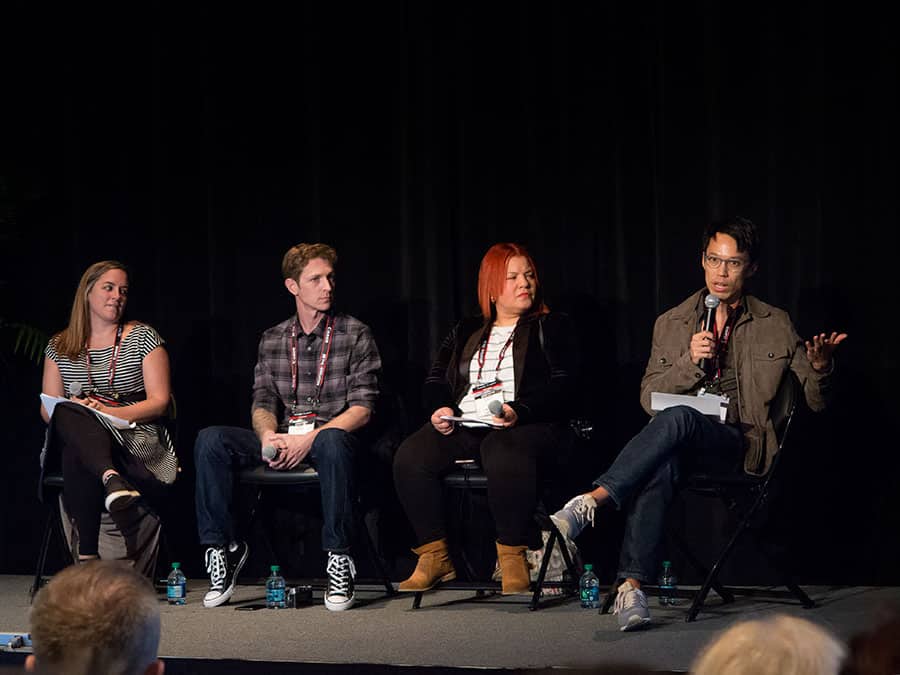
Above: Adriana Teresa Letorney, Dusty Wooddell, Rhynna Santos and Allen Murabayashi discuss social media and photography at PhotoPlus 2018. Photo by Mark Lyndersay.
BitDepth#1173 for November 29, 2018
Four young panelists considered the impact of social media on the craft and business of photography at a keynote discussion at PhotoPlus 2018 last month.
Addressing a large room that was surprisingly half-full, they had a lot of perspectives and concerns about the reality of photography distribution and engagement in the 21st century.
Two were asked to defend the proposition while the other two were expected to cross-examine it.
As it turned out, all the panelists had pros and cons from their experience and weren’t shy about seeing the challenges of the new media experience from both sides.
The conversation considered exposure, the capacity of social media to bring imagery to many viewers in a short time and community, the ability to build meaningful relationships with audiences who engaged with the work and finally the revolution in gatekeeping, moving the curation of distributed and published imagery from the hands of a few to an audience of millions.
For Dusty Wooddell, a young photographer working out of Arizona and a senior writer for the photography website FStoppers, social media was a “redefining of the idea of community.”
“What do you do when your community is physically small with an equally small range of interests?” Wooddell asked.
For him, social media was “one more reason for someone to take photographs.”
Rhynna Santos, a Puerto Rican born, Bronx native, embraced social media as a way to take control of her work and to control its authenticity.
Santos runs a local coalition of women photographers, the Bronx Women’s Photo Collective and Everyday Bronx, part of a project that seeks to build visual community stories from the ground up.
“This abundance of photography offers an opportunity for an abundance of diversity and representation,” said Santos.
“We get involved in producing content and forget that photography is supposed to be fun.”
Adriana Teresa Letorney, CEO of Visura, a development platform designed for storytellers, expressed concerns about the very nature of social media itself.
“Social media is not an open platform, you have to log in to get in,” Letorney said, “and what role is an algorithm playing in the process [of distribution]?”
There wasn’t any question about where Letorney fell on the axis of pros and cons, and she offered articulate and impassioned concerns about the potential dangers of social media and its attendant attractions (and distractions) for photographers.
“We should be able to tell the difference between professional storytellers and everybody else,” Letorney said.
“All the money is over there [with platform developers] and we’re aren’t getting any of it. Content producers should be able to make a decent living.”
Allen Murabayashi, the public face of Photoshelter, a website design and hosting company for photographers sought to find a middle ground in the opinions.
Photoshelter, like Visura, is a creator focused business that seeks to provide an alternative to social media for image discovery and distribution that rewards photographers for their work.
The company recently launched Libris, an enterprise scale image archiving and distribution service that significantly scales up their web-based offerings.
Appearing to support the deep pool of imagery present on social media, Murabayashi suggested that “The ability to find inspiration that gives us creative agency is so important.”
“Communities can be tremendously useful as a way of pooling knowledge and sharing information.”
Are smaller photographer focused communities that reward their creators better in the long run than the massive pool of arbitrary imagery that’s gathered daily by social media?
That’s a question that it will be left to time to decisively answer.


